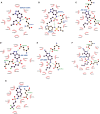Mycobacterium tuberculosis KasA as a drug target: Structure-based inhibitor design
- PMID: 36189349
- PMCID: PMC9519891
- DOI: 10.3389/fcimb.2022.1008213
Mycobacterium tuberculosis KasA as a drug target: Structure-based inhibitor design
Abstract
Recent studies have reported the β-ketoacyl-acyl carrier protein KasA as a druggable target for Mycobacterium tuberculosis. This review summarizes the current status of major classes of KasA inhibitors with an emphasis on significant contributions from structure-based design methods leveraging X-ray crystal structures of KasA alone and in complex with inhibitors. The issues addressed within each inhibitor class are discussed while detailing the characterized interactions with KasA and structure-activity relationships. A critical analysis of these findings should lay the foundation for new KasA inhibitors to study the basic biology of M. tuberculosis and to form the basis of new antitubercular molecules of clinical significance with activity against drug-sensitive and drug-resistant infections.
Keywords: KasA; medicinal chemistry; mycobacterium tuberculosis; structure-based drug discovery; β-ketoacyl synthase.
Copyright © 2022 Rudraraju, Daher, Gallardo-Macias, Wang, Neiditch and Freundlich.
Conflict of interest statement
MN and JF are listed as inventors on patent filings pertinent to the indole and indazole compounds mentioned in this manuscript as employees of Rutgers University. The remaining authors declare that the research was conducted in the absence of any commercial or financial relationships that could be construed as a potential conflict of interest.
Figures









References
-
- Bhatt A., Fujiwara N., Bhatt K., Gurcha S. S., Kremer L., Chen B., et al. . (2007). Deletion of kasB in Mycobacterium tuberculosis causes loss of acid-fastness and subclinical latent tuberculosis in immunocompetent mice. Proc. Natl. Acad. Sci. U.S.A. 104, 5157–5162. doi: 10.1073/pnas.0608654104 - DOI - PMC - PubMed
Publication types
MeSH terms
Substances
Grants and funding
LinkOut - more resources
Full Text Sources

